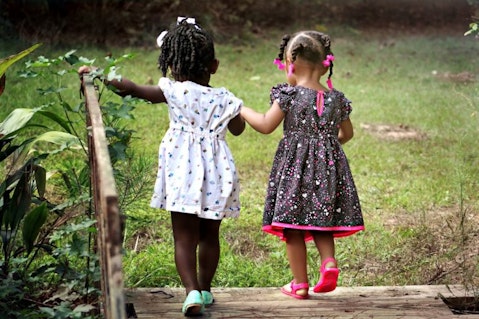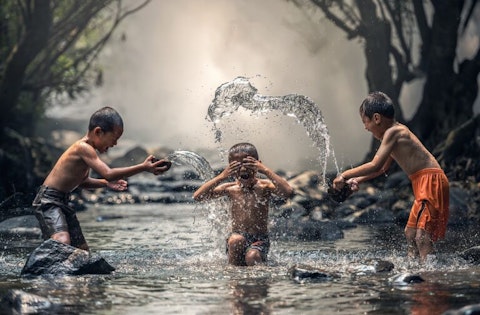If you’re considering international adoption, you might want to explore the easiest countries to adopt a baby from as a starting point. Among the various types of adoption, international adoption could be a favorable option for you.
Social workers distinguish several adoption types, including private domestic adoption (the costliest), foster care adoption, and international adoption. Depending on your time, budget, and preferences, you can choose the most suitable option. It is not strange to choose cheapest countries to adopt from, too. However, international adoption involves multiple steps and preparations before the process can take place.
Many people find international adoption reliable and convenient for several reasons. Domestic adoption often requires substantial finances, strict requirements, and patience in waiting for the right child. Additionally, children available for domestic adoption are often older, which may not be ideal for all parents. There are parents that are looking for countries with no age limit for adoption. In some countries, the adoption laws are complex, leading to prolonged bureaucratic processes.

Pixabay/Public domain
Before deciding on international adoption, you should go through specific steps. First, learn about the adoption process in the country you’re interested in. Each country has its regulations, so consulting with an agency familiar with the process can be beneficial. Those countries that adopt the most, though, face with risks related to corruption and child trafficking, so fulfilling certain conditions becomes necessary. The Hague Convention, an international document governing adoption procedure, offers protection during the process. You should look for countries that adhere to this convention for added security.
Adopting a child from another country comes with challenges. Apart from choosing the right parents, as in any adoption, you must also familiarize yourself with the child’s culture and customs. Be prepared for questions, particularly if the child has a different skin color. Understanding and embracing the child’s heritage is crucial, even when adopting internationally.
Creating a list of the easiest countries to adopt a baby involves considering the specific conditions and rules of each country. Thankfully, there are resources that compile this information, which we used to form our list. The challenge lies in some countries occasionally altering their adoption rules. While certain countries were among the easiest to adopt from in the past, they may have since made the process more difficult. However, some countries consistently rank high on these lists, making them the easiest countries for adoption. We evaluated these countries based on ease, costs, and their frequency of appearance on such lists. Here is our list of the easiest countries to adopt a baby from.

Pixabay/Public domain
20. Malawi
In Malawi, nearly half of the population consists of abandoned children and youth due to broken families, poverty, lack of healthcare resources, and societal challenges. As a result, the number of children who are homeless continues to rise. You can adopt boys and girls aged from infants up to 14 years old. However, keep in mind that although most of the children are generally healthy there is a possibility of malnutrition, and some may be HIV positive. However, it is a part of this list of the easiest countries to adopt a baby from.
19. Togo
Togo places significant emphasis on international adoption, and humanitarian organizations like Save the Children recognize the impact of connecting emotionally with an individual’s needs rather than the collective needs of a group. The concept of sponsoring a child mirrors the adoption experience, with sponsors receiving photos, letters, and updates about the child they have chosen to support. Every family considering adoption must assess whether they can fulfill the specific needs of the child and offer a stable, permanent family environment for the child in question.
18. Jamaica
In Jamaica, individuals aged 25 and above have the legal right to adopt a child or children. However, the law allows those who are 18 years old to adopt younger relatives. Children between six weeks and 18 years old are eligible for adoption in Jamaica. To start the adoption process, you need to fill out a Pre-Adoption form, which is available from the Child Development Agency (CDA). If you are deemed suitable, the CDA will reach out to you and provide an adoption application form and a medical form that you need to complete.
17. Burundi
The adoption process in Burundi is organized through the Christian Adoption Agency, All God’s Children International (AGCI), which has been working directly with the Central Authority in Burundi since 2014. The aim is to place Burundi orphans in loving, safe, and permanent adoptive homes. Due to Burundi’s extreme poverty, there is a significant need for adoptive families in this program. Most children available for adoption in this program are aged between 2 to 12 years old. Additionally, children with medical conditions and sibling groups of all ages are eligible for adoption. The timeframe for the adoption process is approximately 3+ years, from the time of registering the dossier to completion.

Pixabay/Public domain
16. Ghana
Intercountry adoption in Ghana is when individuals or families adopt a child from a country other than their own. Ghana follows The Hague Convention of 29 May 1993 on Protection of Children and Co-operation in Respect of Intercountry Adoption, becoming a contracting state in January 2017. The key principle is to prioritize the best interest of the child. The process is regulated by the same laws, rules, and regulations as in-country adoption. A child qualifies for intercountry adoption if they are legally adoptable and attempts to find a foster or adoptive family within the country have been unsuccessful. To be eligible to adopt a child from Ghana, a person must be between 25 and 50 years old or at least 21 years older than the adoptive child.
15. Honduras
In Honduras, there are many children between the ages of 4 and 10 years waiting for forever families. Sibling groups, especially with older children or more than two siblings, are also in need of families. Children with special needs are also waiting for loving homes and are cared for in both public and private orphanages. To be eligible to adopt from Honduras, heterosexual couples must be between 25 and 51 years old and married for at least three years. Single women between 25 and 51 years of age are also permitted to adopt. Parents must be at least 15 years older than the child, and no more than two divorces per applicant are allowed. Honduras generally prefers referring children to families with three children or less in the home, but they may consider larger families on a case-by-case basis.
14. Hong Kong
Hong Kong has special program that organize international adoption. The adoption program stands out for its unique approach in providing prospective adoptive families with extensive information about the child they are considering. This includes medical reports from the time the child entered care, educational reports, social history, and as much information about the birth family as has been recorded. When a family shows interest in adopting a specific child, they submit an application with the program, the social welfare institute responsible for matching that child with potential adoptive families. This thorough process ensures that families have a comprehensive understanding of the child’s background and needs before proceeding with the adoption.
13. Philippines
In Philippines Adoption Program, most children available for adoption are between the ages of 2 to 15. Families in this program typically wait around 9.4 months to be matched with their child after submitting their contract, and the overall adoption timeline is approximately 21 months, from contract submission to uniting with the child. Around 50% of the waiting children we have placed are under 4 years old, and they may have a varying range of medical conditions. The timeframe for the entire process is typically 1-2 years, starting from the completion of the registered dossier to travel. The actual timeframes may vary depending on the family’s openness to medical conditions, the gender, and age of the child they wish to adopt.
12. Kazakhstan
In Kazakhstan, there are various adoption programs that cater to different types of care for children. These programs are designed to meet the diverse needs of both the children waiting for adoption and prospective adoptive families. Those includes – adoption, foster care, guardianship, custodianship, and foster family. Prospective adopters can choose the type of adoption program that aligns with their preferences, qualifications, and the type of support they wish to provide to the child. Additionally, families may decide to participate in special needs adoption if they feel prepared to provide extra care and support to a child with specific medical or developmental needs. The type of adoption program chosen ultimately depends on the adopters’ willingness, resources, and capacity to care for a child in need of a permanent, loving family. However, keep in mind that international adopting is a subject to restrictions in some cases.

Pixabay/Public domain
11. Ukraine
Unlike some other Eastern European countries, Ukraine follows a different process for adoption. Instead of sending pictures and medical information of children to families in America, families are required to travel to Ukraine to meet the child in person upon their arrival. The great news is that the adoption process in Ukraine is relatively fast, and it should only take around four months from the successful submission of your dossier to complete the adoption. Currently, Ukraine is accepting dossiers, so families can proceed with confidence.
10. Bulgaria
In Bulgaria, children must meet the eligibility requirements set by the Hague Convention for adoption, in addition to any specific requirements under Bulgarian law. Initially, children who are given up by their birth families are made available for domestic adoption. If they cannot find a suitable home within six months, they then become eligible for international adoption. For all adoption cases, Bulgarian authorities carefully assess whether international adoption is in the best interest of the child involved. They place special emphasis on prioritizing children with special needs, which includes children who are over 7 years old or have significant medical conditions. These children are given preference in the adoption process to ensure they find loving families.
9. Haiti
Children in Haiti Adoption program typically range in age from 2 to 8 years old, and they have both single children and sibling groups waiting for adoption. Families interested in adopting from Haiti can choose the gender of their adopted child. The adoption process in Haiti generally takes around 3 to 4 years, starting from the registration of the dossier to its completion. The timeframe may vary based on the family’s openness to medical conditions, the child’s gender, and the child’s age.
8. India
The process of adopting a child in India involves certain prerequisites for the prospective parents’ good physical, mental, and emotional health is required for the adoptive parents. The financial standing of the adoptive parents should be stable, and parents should not have life-threatening illnesses Couples with three or more children are generally not eligible to adopt more kids, unless it’s a child with special needs. Single females can adopt children of any gender, but single males can only adopt boys. The maximum age for a single parent at the time of adoption is 55 and the combined age of the adoptive couple should not exceed 110 years.

Pixabay/Public domain
7. China
Apart from following the Hague Convention regulations, China has its own adoption requirements, which are relatively more stringent compared to other countries. For special needs adoptions, both parents must be aged between 30 and 55 years. In other adoption cases, the age requirement is between 35 and 55 years. The age difference between the adopting parent and the child should not exceed 50 years. For single parents, the age difference with the adopted child cannot exceed 45 years. For married couples, they must have been married for at least two years, while remarried couples should have been married for at least five years. Additionally, prospective adoptive parents are limited to a maximum of two divorces. These regulations are in place to ensure that the adoption process in China is carefully considered and that the best interests of the child are considered.
6. Thailand
As one of the easiest countries to adopt a baby from, Thailand has simple rules for adopting children internationally. Children between the ages of 1 to 15 years are eligible for adoption, but it’s relatively rare for non-Thai-speaking families to receive referrals for children over the age of 10. In some cases, non-U.S. families requesting young, healthy, and unidentified children through special quota system have been approved to adopt children aged 0-12. These families have occasionally received referrals of younger children and have been able to complete the adoption process before the child’s first birthday, as reported in 2007.
5. Bahamas
If you are considering adopting a child in Bahamas, you need to ensure that you meet the eligibility criteria set by Bahamian law for adoption. There are necessary steps of the adoption process. The Adoption of Children Act outlines three main requirements for adoptive parents, and you must be at least twenty-five years old and have an age difference of at least twenty-one years with the child you wish to adopt.
4. South Korea
To be eligible for the South Korea adoption program, prospective parents must meet certain criteria. They should be between 25 and 45 years old when their home study is approved. Couples must be married for at least 3 years to participate. Unfortunately, single parents are not eligible to adopt from South Korea, and they do not currently place children with homosexual parents. Both potential parents must be in good mental and physical health. While it is not impossible, adopting from South Korea may be challenging if either parent has a history of depression or mental illness. Each approved agency working with Korea’s adoption authority will have specific guidelines regarding health issues, such as Body Mass Index (BMI) requirements and the assessment of mental health history or medications.

Pixabay/Public domain
3. Uganda
Children in Uganda face difficult circumstances, as many are orphaned or abandoned due to illness and poverty within their families. HIV/AIDS and malaria have a significant impact on parents and siblings, leaving many children in need of support. With over half of the population under 15 years old, there is a great demand for child-aid in Uganda. Children of All Nations (CAN) is licensed to place children from Uganda. These children come from impoverished homes and may be living with relatives or community members who are unable to care for them. Sometimes, referrals come from orphanages or babies’ homes. Only children who are legally declared as orphaned or abandoned by a judge at the end of the referral process are available for adoption. When considering adopting from Uganda, families should be open to children aged approximately 12 months to 8 years old, with a preference for at least age 3. Additionally, infants from 4 months to 8 years old with special needs are also available for adoption, as well as sibling groups.

Pixabay/Public domain